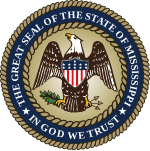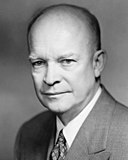| |||||||||||||||||||||||||||||||||||||
| |||||||||||||||||||||||||||||||||||||
| |||||||||||||||||||||||||||||||||||||
| |||||||||||||||||||||||||||||||||||||
| Elections in Mississippi |
|---|
 |
The 1956 United States presidential election in Mississippi was held on November 6, 1956. Mississippi voters chose eight representatives, or electors to the Electoral College, who voted for president and vice president.
Ever since the end of Reconstruction, Mississippi had been a one-party state dominated by the Democratic Party. The Republican Party was virtually nonexistent as a result of disenfranchisement among African Americans and poor whites, including voter intimidation against those who refused to vote Democratic.
From the time of Henry A. Wallace's appointment as vice president and the 1943 Detroit race riots,[2] however, the northern left wing of the Democratic Party became committed to restoring black political rights,[3] a policy vehemently opposed by all Southern Democrats as an infringement upon "states' rights". Consequently, the four states with the highest proportions of (disenfranchised) African-Americans in the populations listed South Carolina Governor James Strom Thurmond instead of national Democratic nominee Harry S. Truman as the "Democratic" nominee in the 1948 presidential election. Although Thurmond easily carried South Carolina, Mississippi, Alabama and Louisiana, Truman won the election.
Nevertheless, demands for civil rights legislation continued to intensify during the following eight years, although the pressing issue of the Korean War meant that Southern Democrats did not run a third-party ticket in 1952;[4] however dissatisfaction with Democrat Adlai Stevenson on civil rights meant Dwight Eisenhower (listed as an "Independent" on the 1952 Mississippi ballot)[5] gained considerable support from the exclusively white electorate of black belt counties,[6] despite having a virtually identical position on civil rights.[4]
After the landmark Brown v. Board of Education decision of 1954, however, Mississippi's rulers realized they could not rely on either major party to enforce segregation and white supremacy. The Citizens' Councils sought to map a regional caucus to deal with this issue, but it feared a split as had occurred in 1948.[7] Nevertheless, the Citizens' Councils did place a slate of unpledged electors on the ballot alongside Eisenhower and Stevenson electors, although state officials, especially incumbent Governor James P. Coleman, strongly opposed them.[8]
Cite error: There are <ref group=lower-alpha> tags or {{efn}} templates on this page, but the references will not show without a {{reflist|group=lower-alpha}} template or {{notelist}} template (see the help page).
- ^ "The Presidents". David Leip. Retrieved September 27, 2017.
Eisenhower's home state for the 1956 Election was Pennsylvania
- ^ Scher, Richard K. (December 31, 1996). Politics in the New South: Republicanism, Race and Leadership in the Twentieth Century. M.E. Sharpe. p. 95. ISBN 1563248484.
- ^ Frederickson, Karl A. (2001). The Dixiecrat Revolt and the End of the Solid South, 1932-1968. Univ of North Carolina Press. p. 39. ISBN 0807849103.
- ^ a b McAdam, Doug; Karina, Kloos (August 18, 2014). Deeply Divided: Racial Politics and Social Movements in Post-War America. Oxford University Press. pp. 76–77. ISBN 978-0199937868.
- ^ Dave Leip's Atlas of U.S. Presidential Elections; 1952 Presidential General Election Results – Mississippi
- ^ Ward, Jason Morgan (November 21, 2011). Defending White Democracy: The Making of a Segregationist Movement and the Remaking of Racial Politics, 1936-1965. Univ of North Carolina Press. p. 156. ISBN 978-0807869222.
- ^ McMillen, Neil R. (1994). The Citizens' Council: Organized Resistance to the Second Reconstruction, 1954-64. University of Illinois Press. p. 317. ISBN 0252064410.
- ^ "Coleman Opposes SR Electors on Mississippi Ballot". The Clarion-Ledger. Jackson, Mississippi. September 21, 1956. pp. 1, 12.




